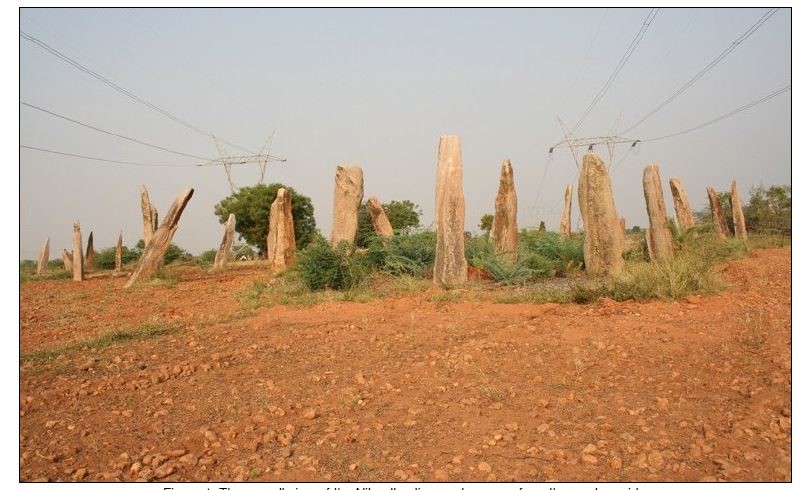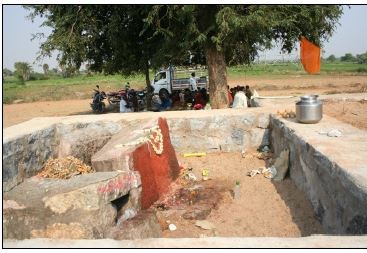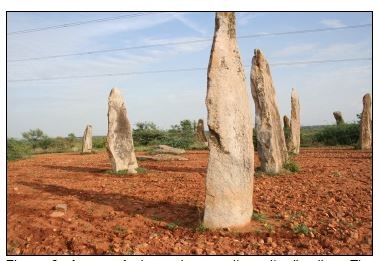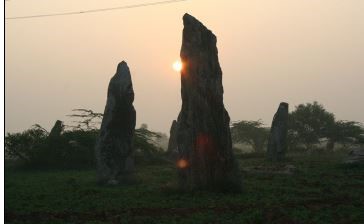Megalithic Trails of Astronomy
Nilurallu in Mehbubnagar district of Andhra Pradesh bears witness to prehistoric ideas of meticulous astronomical calculation. Dr. Maheswar Bahubalendra Singh
The pre-historicity of astronomy is like a fascinating puzzle. Any layman would ponder and rightly so, that astronomy in an era of nomads, in an era of early experiments with agriculture and animal rearing would be just a far fetching improbable idea. But was it so?
experiments with agriculture and animal rearing would be just a far fetching improbable idea. But was it so?
The prehistoric man needed to develop the sky sense which could be a mere hobby horse for the modern times. Knowing and assessing celestial phenomena by sheer observation was akin to have a peek into the cyclical turns and twists of nature herself.
Without this observation and sort of remote sensing, agriculture and non-agricultural activities were next to impossible. One needed to predict the sunrise and sunsets for segregating community activities, hunting for food and other activities related to seasonal life cycle which ensured livelihood and “in-lifeness.” The biological clock and more specifically the menstrual cycle was mimetic of the lunar cycle. So, in short, gauging the extent of day and night was the herald of the months, the seasons and the years.
Several megalithic sites across south India and other locations in Indian subcontinent also establish it as part of world phenomenon. The roots of this can be traced back to not less than 7000 years when curious homo-sapiens began to pursue agriculture as a way of life shifting from the rustic hunter-gatherer lifestyle. Constructing these monuments must have entailed a large amount of time from the day to day struggles for subsistence. Why would these monuments bear testimony to the trails of time? Why were they built to endure? What fascinating soft technology did these represent? These questions riddle every thinker and enthusiast!
 The megalithic culture of South India flourished between 2500BCE-1500BCE, just prior to the advent of the Iron Age in the subcontinent. Out of a number of such sites in Karnataka, Kerala and Andhra Pradesh, the one that never ceases to bamboozle enthusiasts and researchers alike is the site at Nilurallu near Mudumala village of Mahbubnagar district in Andhra Pradesh.
The megalithic culture of South India flourished between 2500BCE-1500BCE, just prior to the advent of the Iron Age in the subcontinent. Out of a number of such sites in Karnataka, Kerala and Andhra Pradesh, the one that never ceases to bamboozle enthusiasts and researchers alike is the site at Nilurallu near Mudumala village of Mahbubnagar district in Andhra Pradesh.
The literal meaning of Nilurallu is “the standing stones.” These non-sepulchral stone arrays show a possible orientation towards cardinal points, the stones being arranged in parallel rows with somewhat equal spacing. This structure is located at latitude 16º 22´44´´ N and longitude 77º 24´4´´ E, south east of Muradodi and Mudumalla village. The river Krishna flows within a kilometer from the site. During spring equinox on 21st March, people throng to Nilurallu to offer prayers which is followed by feasts.
Many ancient cultures had a deep connection with the Equinoxes and Solsctices. They extolled the practice of life being one series of experiments and a ceaseless fabric of observational analytic knowledge. One piece of observation led them to advance further in integrated applied philosophical living which percolated into day to day life. The same meticulousness applies to gazing at constellations and the observation of the movement of various planets out there. Logical inferences drawn from these observations gave direction to the human quest for practical living attuned to nature’s cycles.
In Vedic scriptures, the heliocentricity of our solar system is mentioned. Similarly the velocity of the planets with relation to the Sun is endorsed. This indicates that cultures even predating Vedic period could have known rules and laws of planetary motions and star charts and used it for various purposes, tapping into naturally flowing time frames.
Even to this day, the constellations find great reverence in various rituals across our land. Present day astrology is not possible without a greater corpus of prehistoric astronomy lending its knowledge.
prehistoric astronomy lending its knowledge.
The parallel outlays of stones are distinctly aligned to sunrise and sunsets of solstices and equinoxes. The sun’s motion on the horizon is not uniform, rather accelerates as it approaches equinoxes and slows down as it nears the solstices. At a latitude range of 16-17 degrees the azimuthal travel of the sun as well as the size of the sun’s disc on the horizon was slightly over 50 degrees in 1500BCE on each side of the equinox rise and sunset. The angle is the same as angle measured from the centre of a side to the opposite corners of a square within the error of 2 solar diameters. The Nullirallu alignment is consistent with this picture. The parallel rows facilitate measurement of sunrise and sunset from any direction. Thus the diagonal lines are drawn in parallel to the solstice direction.
Sunrise and sunset spell out transitions of great value to the human mind and body. Transitions are the fundamental principle inherent in day and night, change of seasons, changes in phases of human life. Thus, our ancient masters valued this force of transition as a building block of self–evolving experiential practices. This supports the view that even in the pre-Aryabhatta era, astronomy had found its way into minds and lives of denizens much earlier than we tend to estimate.
 However, it can be said that astronomy picked up tempo around 1500BCE, becoming an auxiliary of the Vedic corpus. The stones of Nilurallu stand as witness to astronomical insights of the prehistoric cultures in the Indian subcontinent.
However, it can be said that astronomy picked up tempo around 1500BCE, becoming an auxiliary of the Vedic corpus. The stones of Nilurallu stand as witness to astronomical insights of the prehistoric cultures in the Indian subcontinent.
Shadows of the menhuirs cast on each other by broad and high neighboring stones form a distinct pattern. It enables to ascertain the time during the day as well as any day to be determined by studying the shadows on the reddish soil on which the stone alignment stands. As the site is slightly elevated, the horizon is clear from all directions.
The stones are separated at an average distance from the centre and each other by 5-6 meters. The stones are made of granite, broad at the base and tapering towards the top, roughly 3-4 meters in height. They exhibit a slab like appearance as their thickness is smaller than the width. The base of the stone seems flat. It is probably made by hammering stones of the same material as the menhuirs. The absence of stone quarries near the site point out that these stones originated somewhere else and were transported from a distance to this site. One would simply balk at how these really heavy stones were transported and shaped in the absence of presently available tools and machinery.
The absence of evidence of iron tools and the method of transportation has baffled researchers. Construction of the site can be dated between 1500BCE-1000BCE, which is just before the onset of Iron Age in South India.
The uniqueness of the Nillurallu alignment is that it is surrounded by smaller arrays of smaller stones set roughly 11 meters apart aligned with the larger menhuirs at the point of east-west and north-south. This makes Nillurallu an integral part of its astronomical surrounding. A stone present on southwestern part of the site is replete with 30 odd cup marks on its surface. Claims say that this depicts the Ursa Major or Great Bear constellation. On the other hand this could also be a blueprint of the entire complex which was designed prior to its construction. It is known that indigenous tribes of the subcontinent represented these constellations with animistic figures through various cave paintings and seals. Like the constellations of the autumnal equinox was represented by elephant, later the Scorpio; vernal equinox by the buffalo or bull; summer solstice by the tiger later the lion; and the winter solstice by the boar.
The megalithic structures at Nilurallu, which is relatively better preserved than its counterparts in other sites of South India, bears witness to the ingenuity of the prehistoric tribes and their deep alignment and respect for nature which indicates their skills in remote sensing. Their imprints carefully shaped with simple yet elegant technology make us ponder about the great natal connection with the flow of life in itself.